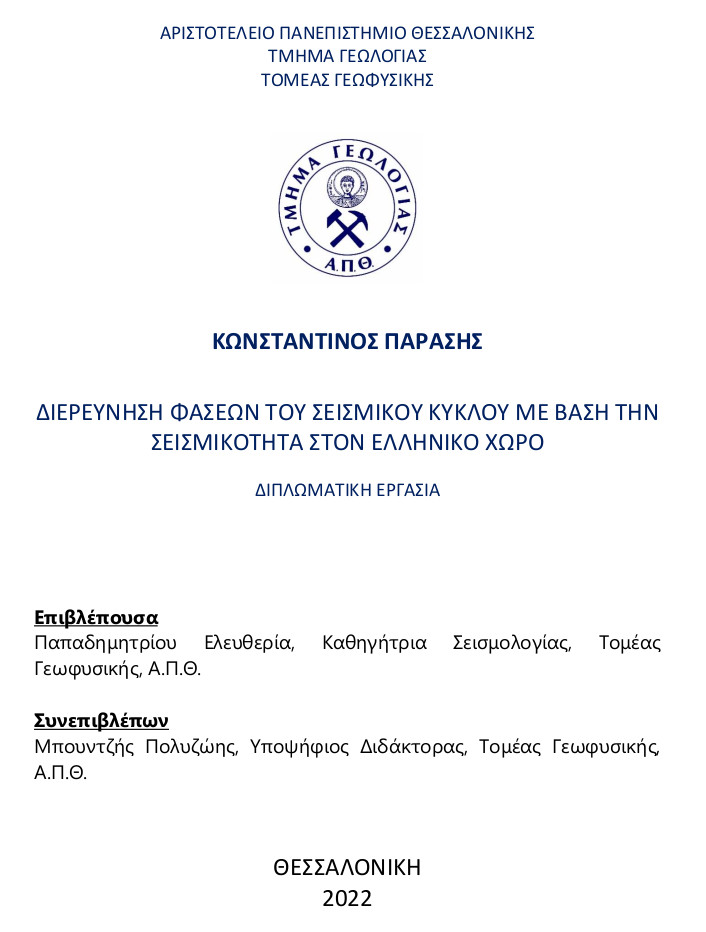
Διερεύνηση φάσεων του σεισμικού κύκλου με βάση την σεισμικότητα στον ελληνικό χώρο = Phase Investigation Of The Seismic Circle Based On Seismicity In The Area Of Greece.
Περίληψη
The purpose of this paper is the study of the seismic cycle in the North Aegean Trough during the period 1964-2020. This period was divided into 4 subperiods, namely, from 1964 to 1995, from 1996 to 2007, from 2008 to 2011 and finally from 2012 to 2020. The area was divided into circles with a fixed radius of 0.20 degrees which overlap as their centers are at a distance of 0.15 degrees. The magnitude of completeness, Mc, was determined in the sample of earthquakes contained in each cycle, and the values of parameters a and b of the Gutenberg-Richter relation (1994) and the frequency of Mc earthquakes, were also calculated. The spatial distribution of the calculated parameters is shown on maps constructed by applying the GMT program.
Πλήρες Κείμενο:
PDFΑναφορές
Amorèse, D. 2007. Applying a change-point detection method on frequency-magnitude distributions. Bull. Seismol. Soc. Am. 97, 1742-1749.
Brooks, M., & Ferentinos, G. 1980. Structure and evolution of the Sporadhes basin of the North Aegean trough, northern Aegean Sea. Tectonophysics, 68, 15-30.
Bulut, F. 2015. Different phases of the earthquake cycle captured by seismicity along the North Anatolian Fault. Geophys. Res. Lett., 42, 2219-2227.
Cao, A.M. &Gao, S.S., 2002. Temporal variation of seismic b-values beneath northeastern Japan island arc. Geophys. Res. Lett., 29(9), 48(1)-48.
Gomberg, J. 1991. Seismicity and detection/location threshold in the southern Great Basin seismic network. J. Geophys. Res., 96, 16401-16414.
Gutenberg, B. &Richter, C. F. 1944. Frequency of earthquakes in California. Bull. Seismol. Soc. Am., 34, 185-188.
Karakostas, V., Papadimitriou, E., & Gospodinov, D. 2014. Modelling the 2013 North Aegean (Greece) seismic sequence: geometrical and frictional constraints, and aftershock probabilities. Geophys. J. Int., 197, 525-541.
Kourouklas, C., Papadimitriou, E., Tsaklidis, G., & Karakostas, V., 2016. Statistics of earthquake recurrence time in North Aegean Trough. Bull. Geol. Soc. Greece, 50, 1349-1358.
Kourouklas, C., Papadimitriou, E., Tsaklidis, G., & Karakostas, V. 2018. Earthquake recurrence models and occurrence probabilities of strong earthquakes in the North Aegean Trough (Greece). J. Seismol., 22, 1225-1246.
Kourouklas, C., Console, R., Papadimitriou, E., Murru, M., & Karakostas, V. 2021. Modelling the large earthquakes recurrence times along the North Aegean Trough Fault Zone (Greece) with a physics-based simulator. Geophys. J. Int., 225, 2135-2156.
Kværna, T., Ringdal, F., Schweitzer, J., & Taylor, L. 2002. Optimized seismic threshold monitoring part 1: regional processing. Pure Appl. Geophys, 159, 969-987.
Kværna, T., Ringdal, F., Schweitzer, J., & Taylor, L. 2002. Optimized seismic threshold monitoring part 2: teleseismic processing. Pure Appl. Geophys., 159, 989-1004.
Leptokaropoulos, K. M., Papadimitriou, E. E., Orlecka-Sikora, B., & Karakostas, V. G. 2012. Seismicity rate changes in association with the evolution of the stress field in northern Aegean Sea, Greece. Geophys. J. Int., 188, 1322-1338.
Lybéris, N. 1984. Tectonic evolution of the North Aegean trough. Geol. Soc., Lond., Spec. Publ., 17, 709-725.
Mignan, A., & Woessner, J. 2012. Estimating the magnitude of completeness for earthquake catalogs. Community Online Resource for Statistical Seismicity Analysis, 1-45.
Mogi, K. 1967. Effect of the intermediate principal stress on rock failure. J. Geophys. Res, 7220, 5117-5131.
Papazachos, B.C. 1975. Foreshocks and earthquake prediction. Tectonophysics, 28, 213-226
Papazachos, B. C., & Comninakis, P. E., 1971. Geophysical and tectonic features of the Aegean arc. J. Geophys. Res., 76, 8517-8533.
Saltogianni, V., Gianniou, M., Taymaz, T., Yolsal‐Çevikbilen, S., & Stiros, S., 2015. Fault slip source models for the 2014 Mw 6.9 Samothraki‐Gökçeada earthquake (North Aegean trough) combining geodetic and seismological observations. J. Geophys. Res.-Sol. EA, 120, 8610-8622.
Rydelek, P. A., & Sacks, I. S. 2003. Comment on “Minimum magnitude of completeness in earthquake catalogs: Examples from Alaska, the Western United States, and Japan,” by Stefan Wiemer and Max Wyss. Bull. Seism. Soc. Am., 93, 1862-1867.
Scholz, C.H., 1968. The frequency magnitude relation of microfracturing in rocks and its relation to earthquakes. Bull. Seismol. Soc. Am., 58, 399-415.
Wiemer, S., & Katsumata, K. 1999. Spatial variability of seismicity parameters in aftershock zones. J. Geophys. Res., 104, 13135-13151.
Wiemer, S., & Wyss, M. 2000. Minimum magnitude of completeness in earthquake catalogs: Examples from Alaska, the western United States, and Japan. Bull. Seismol. Soc. Am., 90, 859- 869.
Woessner, J. & Wiemer S. 2005. Assessing the Quality of Earthquake Catalogs: Estimating the Magnitude of Completeness and Its Uncertainty. Bull. Seism. Soc. Am., 95, 684-698.
Εισερχόμενη Αναφορά
- Δεν υπάρχουν προς το παρόν εισερχόμενες αναφορές.
